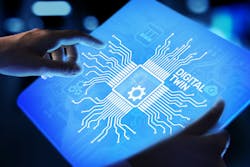Real words or buzzwords?: Digital Twin
Editor’s note: This is the 38th article in the "Real Words or Buzzwords?" series from SecurityInfoWatch contributor Ray Bernard about how real words can become empty words and stifle technology progress.
While there are numerous definitions that can be found for “Digital Twin” and what it encompasses, the term, in its most basic form, is used to describe an electronic copy of something that exists in the physical world. Per Wikipedia: “Digital twin refers to a digital replica of physical assets (physical twin), processes, people, places, systems and devices that can be used for various purposes. The digital representation provides both the elements and the dynamics of how an Internet of Things (IoT) device operates and lives throughout its life cycle.” Since electronic physical security systems contain from hundreds to thousands of IoT devices, it certainly seems like an applicable concept.
However, it’s a very broad concept that covers a lot of ground: processes, people, places, systems and devices. It’s a commonly understood term in many IT domains. First, because IT service management uses digital twins of IT infrastructure to monitor and predictively service the infrastructure to prevent outages. Second, because software engineers and coders are the people who create most digital twins.
Although few people in physical security are familiar with the term, it’s very relevant in at least three domains.
Infrastructure Management
Local, regional, national and global physical security systems all have IT and IoT-based electronic systems infrastructure that requires IT and IoT tools to manage that provide and act on infrastructure situational awareness. Some of the IT infrastructure is moving to the cloud, but not all of it, as cameras and other sensors, as well as control devices such as for physical access, must remain on-premises. IT has been using digital twin technology for most of the past decade for infrastructure management. Viakoo comes to mind as the leader in this area.
Smart Buildings
Smart buildings are built environments that use digital twin technology to varying degrees for managing (monitoring and controlling) the occupant and visitor building experience. Security technology and systems can play a much bigger role that it currently does, for example, via integrations involving indoor locating, security video and AI-enhanced video analytics, and digital signage.
Currently, building use access card presentations and/or elevator call kiosks serve that purpose, but the single points of interface aren’t a good match for high-volume visitor periods, or emergency evacuation scenarios. Heat map and/or people-counting information from video cameras could increase the accuracy of priority-setting in busy elevator systems across a wider set of operations scenarios.
Presence Control
An earlier article on presence control presents the emerging concept for extending physical access control into open areas and building shared, common and use-on-demand spaces, and thanks to emerging technology is a highly workable concept. For example, some R&D and manufacturing facilities have high visitor and contractor traffic, and experience situations in which multiple customer visitors are competitors to each other, and so must be kept in separate building spaces where they won’t cross paths. A presence control digital twin is a great way to do this, whether it is a visual model or an operational model that manages the situation by scheduling of meeting rooms, visitor arrival and departure times, and visitor sponsor notifications.
Systems that maintain awareness of personnel locations can be an effective part of emergency response planning in numerous ways. For example, by pairing up at-risk individuals (accident, health emergency, individuals needing special assistance in evacuations) with designated trained response personnel in closest proximity.
There are also situations in manufacturing and mining facilities where if people spend a certain amount of time in Building A, they can’t go into Building B because Building A chemicals are still in their bloodstream from breathing Building A’s air, and they can’t safely breathe in Building B’s air. RightCrowd has technology that addresses such situations and more, via integration with facility access control systems.
Design Thinking
Digital twin technology provides:
- Real-time functionality
- Preventive, predictive and responsive situation assessment per an updated knowledge base
- Automatic actions with audit trail per configuration and programming
- Ongoing situational awareness and assistive action support to human responders
Whether looking to improve the built environment experience for occupants and visitors, or addressing risk situations, digital twin technology can become a big help as long as we keep it in our design “thinking caps.”
Let’s Catch Up with Technology
Digital twin concepts and technologies is another area where physical security lags IT and other industries. Although several security technologies have emerged using digital twin elements, we need more of them.
About the Author:
Ray Bernard, PSP CHS-III, is the principal consultant for Ray Bernard Consulting Services (RBCS), a firm that provides security consulting services for public and private facilities (www.go-rbcs.com). In 2018 IFSEC Global listed Ray as #12 in the world’s Top 30 Security Thought Leaders. He is the author of the Elsevier book Security Technology Convergence Insights available on Amazon. Mr. Bernard is a Subject Matter Expert Faculty of the Security Executive Council (SEC) and an active member of the ASIS International member councils for Physical Security and IT Security. Follow Ray on Twitter: @RayBernardRBCS.
About the Author

Ray Bernard, PSP, CHS-III
Ray Bernard, PSP, CHS-III, is the principal consultant for Ray Bernard Consulting Services (RBCS), a firm that provides security consulting services for public and private facilities (www.go-rbcs.com). In 2018 IFSEC Global listed Ray as #12 in the world’s top 30 Security Thought Leaders. He is the author of the Elsevier book Security Technology Convergence Insights available on Amazon. Ray has recently released an insightful downloadable eBook titled, Future-Ready Network Design for Physical Security Systems, available in English and Spanish.
Follow him on LinkedIn: www.linkedin.com/in/raybernard.
Follow him on Twitter: @RayBernardRBCS.
